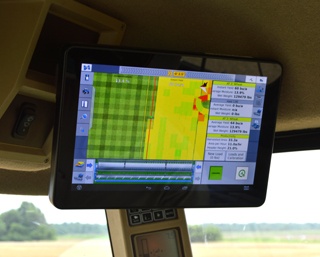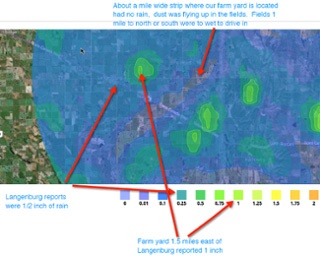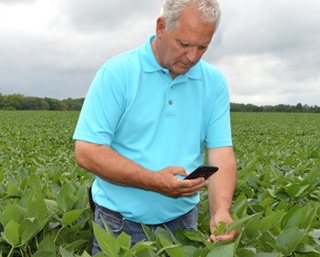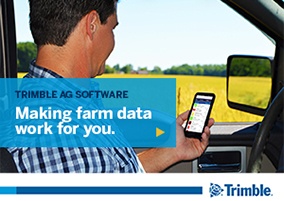Thanks to great advances in precision ag technology, we now understand that crops grow in a five-dimensional sea of variability – up, down, right, left... plus time and economics.
To optimize yield and ROI, keeping budgets and the environment in mind, we need to manage crops using greater focus.
Fortunately, as technology improves and our understanding of how to use the information generated by that technology grows, so too does our ability to begin to manage agronomics in a a more precise manner.
TIME TO EXPAND YOUR TECHNOLOGY TOOLBOX!
Farmers have an ever-expanding toolbox of technology that can help them get more and more efficient with inputs and logistics, with less worry and stress. For the purposes of this blog, we're going to link three technologies: yield monitors, tissue tests and remote weather stations (primarily rain gauges) by considering them as different, yet complimentary lenses into a farm operation — much like a compound microscope with the eyepiece lens works in concert with the rotating objective lenses to have ever-increasing magnification levels.
1: LEVERAGE YIELD MONITORS
 Yield monitors are like the eyepiece lens of the microscope as it expresses farm data at the coarsest level with big picture focus. Yield is the final integration of everything that has happened in every particular field for that specific year – rainfall, climate, tillage system, rotation, pest control, seeding, nutrient management, etc. Taken from the yield monitor and formatted into a yield map, this is where the yield data really becomes a powerful tool as we ask ourselves, 'Why does this portion of the field yield differently than that portion of the field?'
Yield monitors are like the eyepiece lens of the microscope as it expresses farm data at the coarsest level with big picture focus. Yield is the final integration of everything that has happened in every particular field for that specific year – rainfall, climate, tillage system, rotation, pest control, seeding, nutrient management, etc. Taken from the yield monitor and formatted into a yield map, this is where the yield data really becomes a powerful tool as we ask ourselves, 'Why does this portion of the field yield differently than that portion of the field?'
Taken one-step further, using yield maps plus as-applied maps and real costs, we can produce profit maps that visually show us which fields or parts of fields were most profitable. Which should make us ask, 'Why is this portion of the field more profitable than that portion of the field? Answering the 'why' provides a foundation for subsequent year’s crop production. Unfortunately, very few growers understand the full value of their yield data. We want to change that.
2: MONITOR RAINFALL
 In Grandpa’s day, a single rain gauge near the homestead was a best management practice. Now we have access to remote rain gauges, whether it on-farm weather stations or premium weather feeds. This next lens of resolution enables us to manage on a much finer scale is becoming the new best management practice.
In Grandpa’s day, a single rain gauge near the homestead was a best management practice. Now we have access to remote rain gauges, whether it on-farm weather stations or premium weather feeds. This next lens of resolution enables us to manage on a much finer scale is becoming the new best management practice.
As farms grow in size, fields become more distant and scattered. It’s not unusual for a farm to have fields 20–30 miles apart. A lot can happen over this distance making it extremely difficult to manage individual fields that are miles from the homestead.
So what do we do? We drive around an awful lot! The map above is a screen shot of a Trimble Ag Software Premium Weather feed showing an example of where a significant rainfall event took place. The home yard received no rain while numerous fields received 1+ inches, making field operations impossible while significantly enhancing yield potential and disease pressure. With this type of information, we can focus to make better logistical decisions while also identifying fields with higher yield/disease potential thereby further focusing specific in field decisions/operations. Remember, water drives everything and an additional 1 inch of precipitation can easily translate into 7+ bu/ac of canola!, which requires additional nutrient input to be captured.
3: EMBRACE TISSUE TESTS
 This brings us to the next level of resolution or lens to look through and that is the tissue test. Now that we know based on our yield maps and perhaps our rainfall maps, where the yield potential is significantly greater. We can now employ tissue tests to see exactly how the crop is tracking nutritionally and if additional nutrients are required, especially nitrogen, sulphur and boron(all soil mobile) for canola, then we can pull soil/foliar applied triggers to capture that yield once the field is trafficable again.
This brings us to the next level of resolution or lens to look through and that is the tissue test. Now that we know based on our yield maps and perhaps our rainfall maps, where the yield potential is significantly greater. We can now employ tissue tests to see exactly how the crop is tracking nutritionally and if additional nutrients are required, especially nitrogen, sulphur and boron(all soil mobile) for canola, then we can pull soil/foliar applied triggers to capture that yield once the field is trafficable again.
There are many other tools available such as soil tests, resin tests or imagery when used properly can help sharpen our agronomic focus. Sometimes we can fall, mistakenly, into the trap of looking at technology/tools as just another expense, but in the right hands and used with the goal of dialing in to create greater efficiencies, they are an investment.
We are excited with the agronomic insights these tool provide agronomists, who can then pass them on to growers. Consider the technologies coming at us as transformative lenses that allow us to visualize the world in completely different ways, allowing better decisions, more efficient re-allocation of scarce resources, greater profitability AND environmental enhancement.
As we integrate these lenses of insight, our ability to manage profit expands... exponentially.
.jpg)

